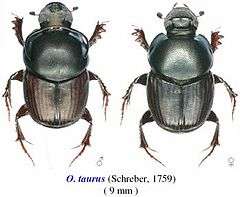Onthophagus taurus
| Onthophagus taurus | |
|---|---|
| | |
| Onthophagus taurus. Museum specimen | |
| Scientific classification | |
| Kingdom: | Animalia |
| Phylum: | Arthropoda |
| Class: | Insecta |
| Order: | Coleoptera |
| Family: | Scarabaeidae |
| Subfamily: | Scarabaeinae |
| Genus: | Onthophagus |
| Species: | O. taurus |
| Binomial name | |
| Onthophagus taurus (Schreber, 1759) | |
The taurus scarab (Onthophagus taurus) is a species of dung beetle in the genus Onthophagus. [1]

Description
Onthophagus taurus can reach a length of 5.5–11 millimetres (0.22–0.43 in). These small beetles are oval shaped, the color is usually black or reddish brown. Sometimes the pronotum has a weak metallic sheen. Males have on the heads a pair of long protrusions or horns (hence the species name) that they use to fight with each other to gain mating rights with females.
Some males do not have horns, and therefore do not come into the fight, but have larger gonads. A similar dimorphism in males have been found in some other species (Ageopsis nigicollis, Podischnus agenor). This adaption reduces direct competition with horned males. [2]
Onthophagus taurus can pull a weight of 1141 times its own body mass and is considered the strongest animal on earth on a body weight to lift ratio.[3]
Distribution
This species is present in Europe, Morocco, Algeria, Tunisia, Syria, Iraq, Transcaucasia, Asia Minor, Iran, Afghanistan, Central Asia and USA (Texas).[4]
Economic value
Dung beetles have been utilized in the breakdown of manure on sheep and dairy farms worldwide.[5]
In September 2013 O. taurus was released for the first time in New Zealand, in the Gore District of Southland.[6] These beetles pull the manure into the ground to create their brood balls, which they use as egg chambers.
This increases grazing space for cattle, reduces habitats for flies and bacteria, and reduces the need for chemical fertilizers.[7]
References
- ↑ Hallan, Joel «Synopsis of the described Coleoptera of the World»
- ↑ Eberhard, W. G. Beetle horn dimorphism: making the best of a bad lot The American Naturalist. — 1982. — Vol. 119, № 3. — P. 420-426..
- ↑ ABC Science
- ↑ Catalogue of life
- ↑ Losey, John E.; Vaughan, Mace (2006). "The economic value of ecological services provided by insects". BioScience. pp. 311–323.
- ↑ Media Release
- ↑ Nelson, Frank (October 21, 2011). "New Zealand imports foreign workers: dung beetles". Pacific Standard. Retrieved December 27, 2012.